Lab-to-Lab: US-Russian Lab-to-Lab Collaboration Story [Archived]
Early Lab-to-Lab | Export Control | Nielsen Jr. | Symposia | WSSX
Physics | Reminiscences of Russia | Caroline (Cas) Mason
- Setting the Stage
- Forming Collaboration
- Frequent Experimental Campaigns Part 1
- Frequent Experimental Campaigns Part 2
- Broadening and Declining Collaboration
- Restoring Collaboration
- Epilogue 2006-2016
- Concluding Remarks
This three-year period saw the collaboration broadening with small efforts initiated in a number of new areas, and a number of LANL personnel visited VNIIEF for the first time. In addition, joint experiments at LANL on the Pegasus and Atlas capacitor banks were being planned and some trips to VNIIEF were aimed specifically at defining new contracts and experiments at LANL. The collaboration became more involved in experiments and other projects conducted under the auspices of the ISTC.
Even as the collaboration was trying to grow, there were harbingers of bureaucratic impediments yet to come. VNIIEF reported increasing difficulty in getting permission for U.S. scientists to enter Sarov. The U.S. Department of Commerce changed its export license requirements for anything being shipped to VNIIEF, which had been put on the Commerce department “entities” list. There was even an attempt to require an export license as a prerequisite for technical discussions. These new regulations seriously complicated the process of getting U.S. government country clearance to travel to Russia and resulted in several near-cancellations of trips.
Shipments of LANL equipment to VNIIEF for experimental campaigns in October 1997 and August 1998 were held up in the licensing process, and I and others spent countless hours writing letters and memos to Commerce and Defense Department personnel, talking on the phone with them, and even travelling to Washington for briefings in an attempt to rescue the shipments. One official stated “you were caught in a backlash that has been building for two years.”
In spite of the bureaucratic issues, for the LANL team, 1997-1999 was a good period to visit Sarov. VNIIEF security regulations were much less restrictive than in the past as VNIIEF security seemed to settle into a reasonable balance between security concerns and operational concerns, as well as an apparent recognition that social activities were an important part of the relationship. School visits, excursions outside the city, meetings with the English Club and meetings with the Sarov Duma to discuss the Los Alamos/Sarov Sister Cities program and medical exchanges had become the norm. The LANL visitors were hosted for dinners in the homes of scientists, teachers, friends and Duma members. Lydia Alexandrovna Ilkaeva frequently arranged tennis for the visitors, and VNIIEF Director Radii Ivanovich Ilkaev occasionally joined the competition.
As always, school visits were highlights of the trip. Although we were sure the students wouldn’t agree, we were always glad that school was in session on Saturdays, while VNIIEF was closed, giving us an ideal time to visit. The visits always included talent displays (e.g., music, dancing, martial arts, etc.) and lots of questions from the students. We know of nowhere else where LANL scientists are surrounded by students wanting autographs.
During this period, the VNIIEF team also made a number of trips to Los Alamos.
October 1997
To our surprise as Bartsch, Ekdahl, Faehl, Reinovsky and I walked into the auditorium of school #15, there in front of our eyes on the stage interspersed with the younger students were two of the students whom we had accompanied to Los Alamos in April 1994 and whom had won the hearts of the Los Alamos community with their beautiful voices. We knew that they had long since graduated, but apparently they had been recruited for a special performance for the Los Alamos delegation. As this example illustrates, our many visits to Sarov actually gave us a number of opportunities to watch the children of Sarov grow into young adults.
April 1998
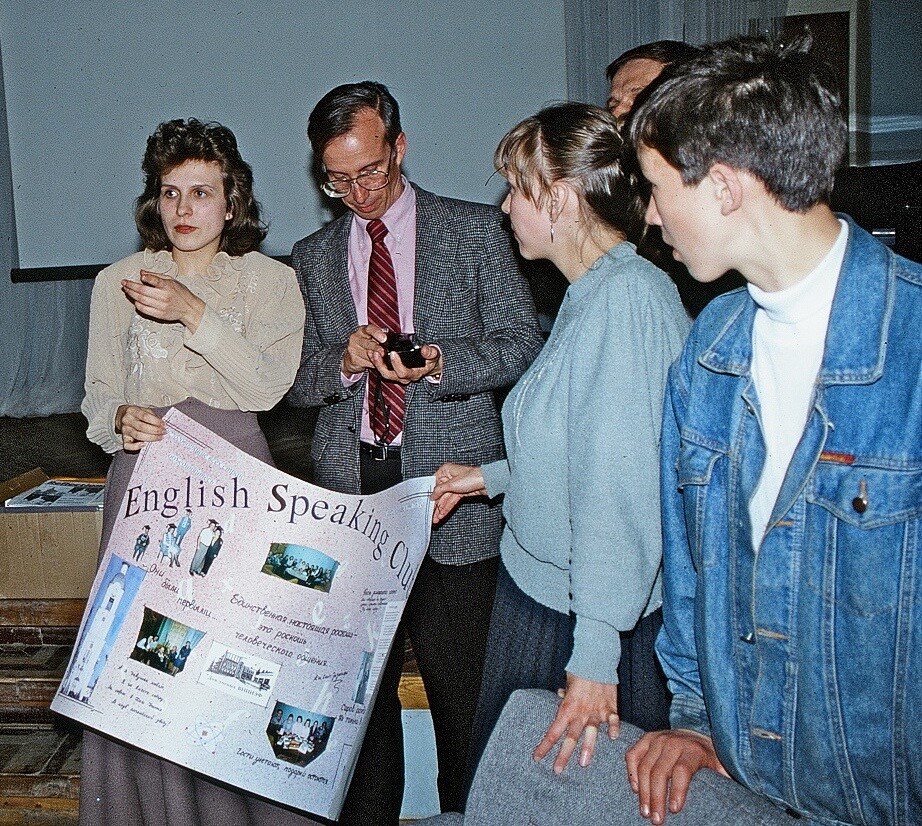
The Sarov English Club (and Bob Reinovsky, in sport coat and tie) displays a poster telling the Club’s history; a poem by Brodie Anderson appears on the right side of the poster; the photo in the upper middle depicts a visit to the Club by a LANL delegation.
Even though Anderson had not accompanied us on the October 1997 trip, once again one of his poems was recited by a young student at the English Club. When nine of us (Atchison, Roger Bartlett, Bartsch, John Benage, Faehl, Ladish, Reinovsky, Sheehey, and me) visited the English Club again in April, LANL team pictures and one of Anderson’s poems were featured prominently on a poster that the Club had prepared describing its history. Since even Anderson himself had not retained copies of the poems, we asked for, and were given, copies of the three poems. The handwritten poems had been retyped by the Club under the byline “Brodie (Pushkin) Anderson.”
VNIIEF security was always happy when the LANL team left Sarov on weekends. A weekend excursion took us to Nizhni Novgorod and a park that had many reconstructed 17th, 18th, and 19th century buildings and churches. Normally, the park is closed for the winter until May 1, but special arrangements were made for the LANL team, who was escorted through still-deep snow by an 80-year-old guide who spoke reasonable English.
I paid the admission for the entire team to the park. As was the case in the Soviet Union, the admission taker insisted on providing receipts for the fee paid. However, the receipts available were in units of “old” roubles, not in the “new” roubles (that had a value of 1000 times the old roubles), so I was given a huge stack of receipts.
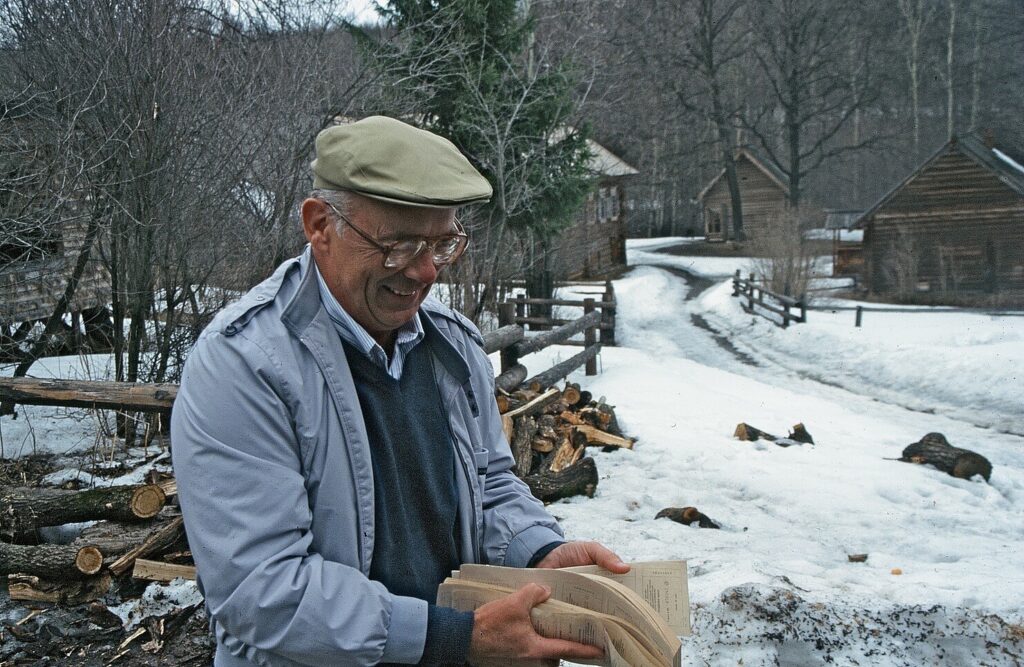
“Old” rouble receipts for park admission (Nizhni Novgorod, April 1998).
George Crile, CBS 60 Minutes producer and later the author of the best-seller Charlie Wilson’s War, flew from Moscow on the same flight as the LANL team and learned from Atchison that the LANL delegation was aboard. Upon deplaning in New York, Crile quickly began inquiring about the team’s trip. When Crile learned that two of the bags I was carrying contained “pen-pal” letters, Crile hurriedly unpacked his video camera and began filming the bag contents. Video camera in hand, Crile accompanied the team to its next flight, conducting interviews along the way.
In response to a follow-up e-mail message I had sent him, Crile wrote in an e-mail message:
I’m so pleased just to know that all of this has happened and that it is still underway. For the moment I will just leave you and your colleagues with a preliminary reaction: Congratulations! You make me proud.
August 1998
The LANL team (Anderson, Benage, William Broste, Goforth, Kirkpatrick, Oona, Reinovsky, Richard Siemon, Darin Westley, and me) returned to Sarov in August 1998 when the joint team was to conduct several experiments. Because experiments were to be conducted at three different experimental sites, and because a large number of data channels were to be used to record several very complex plasma diagnostic systems, this visit represented perhaps the most ambitious experimental campaign yet.
Westley was making his first trip to Sarov. Westley became fascinated with Sarov’s tall pine trees that had branches only near the top and seemed to have no bark on the bottom. When Westley noted the white trunks, Anderson explained that the lower bark had been removed by the “Russian bark bears” that climbed the trees for food. For a time, Westley was hoping to see these bears, until he finally realized that he had been deceived.
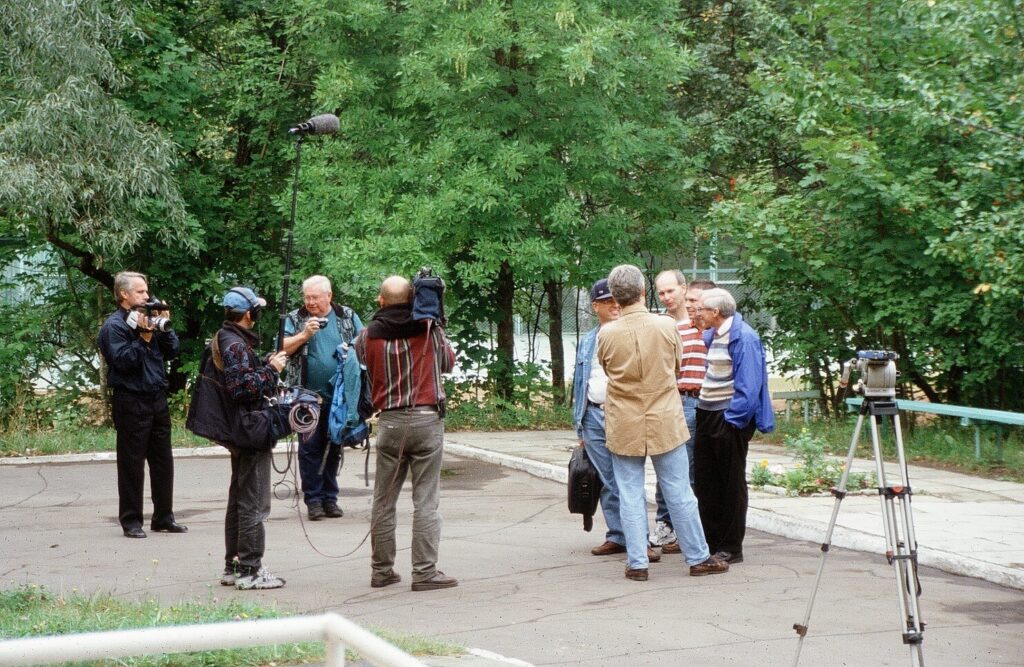
Anatoli Buyko (left) and Sergei Garanin (right) bring bags of “pen pal” letters to the LANL delegation’s hotel in Sarov. The author is in the center (October 1999)
With my assistance, George Crile and his video team had obtained unprecedented Russian government permission to accompany the LANL team to Sarov. Crile, his cameraman, and his assistants spent the week filming the joint experimental activities and interviewing the participants for what Crile had hoped would become a documentary program on the uniqueness of the relationship. Because Crile was not permitted into the firing area, he handed me a camera and I filmed the experimental activities.
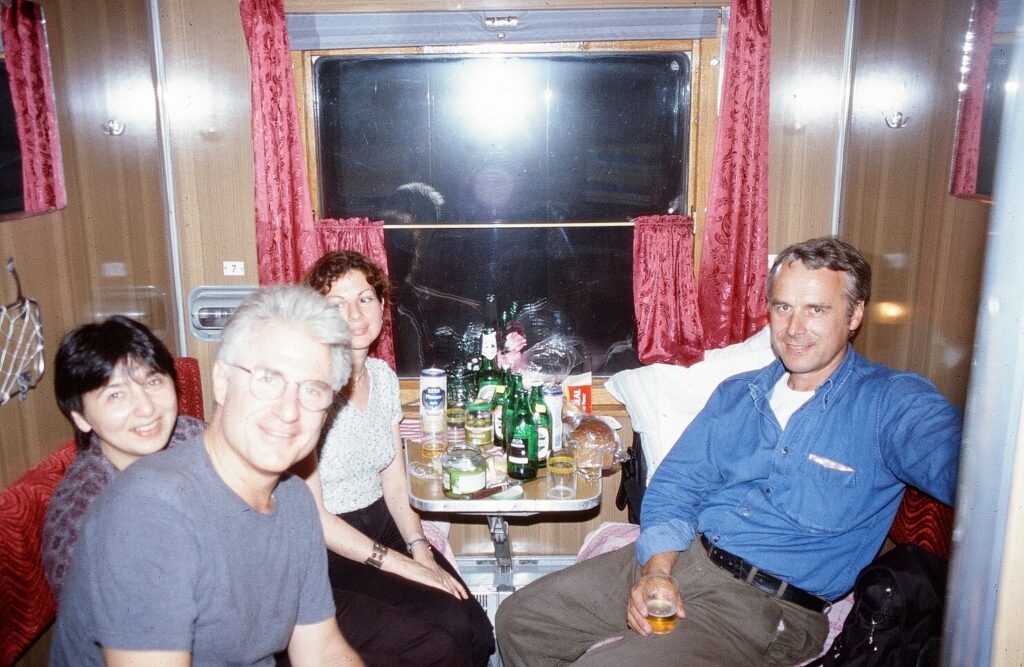
George Crile, CBS 60 Minutes producer and author of best-seller Charlie Wilson’s War (second from left) and his team accompanies the LANL team on train to Sarov (August 1998).
Unfortunately, before all of the planned experimental work had been completed and before any progress toward defining expanded collaboration was made, LANL management ordered the LANL delegation to return to the United States immediately and banned travel to Russia by all LANL personnel. The reasons for the order to return to the United States were never made public, but the ban that had been put on lab employees’ travel to Russia—after the team had already arrived in Sarov—was lifted just three days later, the day after the LANL team had left Sarov.
October 1999
A nine-member LANL team (Anderson, Atchison, Clark, Faehl, Goforth, G. Rodriguez, John Stokes, Lenny Tabaka, and me) spent a three-week period in Sarov in October and November 1999. The purpose of the visit was to conduct an experiment using a DEMG to provide U.S. scientists with the first available data on the behavior of magnetically imploded liners in the upper current performance level predicted for the U.S. Atlas capacitor bank then under construction.
During this visit, we were invited to go to the “banya” with members of the Sarov Duma who had visited Los Alamos in December 1998. During their Los Alamos visit, the Duma members had attended a Christmas concert by well-known western singer, Michael Martin Murphey, whom I had introduced to the Russians and who had dedicated “Tumbling Tumbleweeds” to the visitors during his concert. Therefore, for the entire evening, Murphey’s music echoed throughout the banya facility.
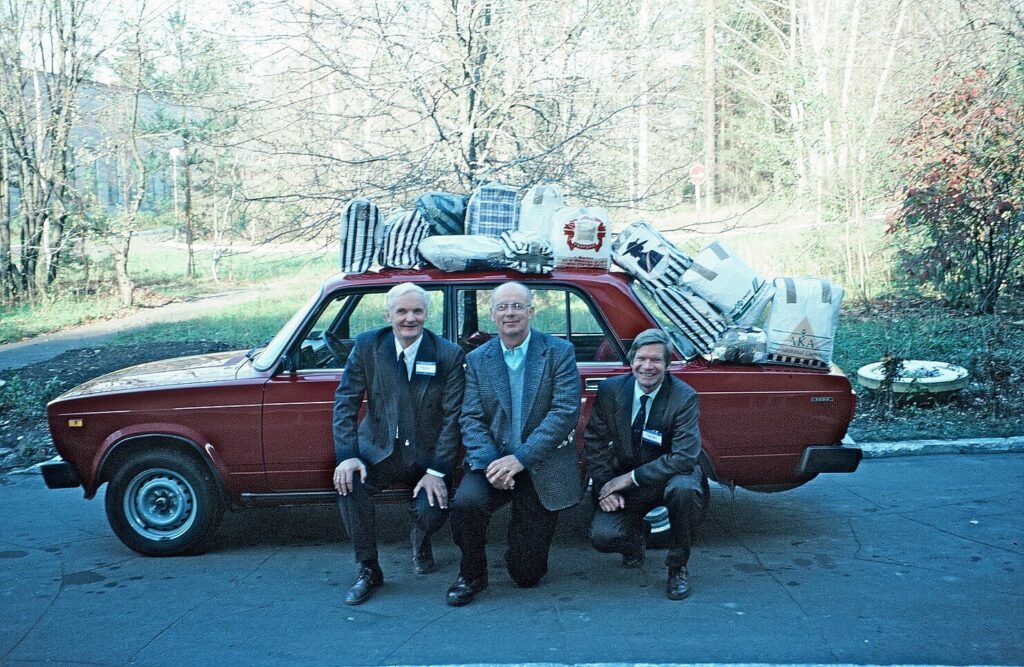
Shoes sit outside the room of “shoe-sign boy” Lenny Tabaka (Sarov, November 1999)
“Pen pal” letter exchanges were the initial basis for the Sister Cities relationship, and by November 1999, hundreds of letters were being carried to and from Sarov by each traveling LANL or VNIIEF delegation. Since the bulk of the letters was becoming too large for what little spare suitcase space the travelers had, Jim Goforth donated an old blue suitcase to the cause, and this suitcase always travelled with delegations from both institutes.
An unidentified middle-aged Sarov woman followed the LANL delegation from room-to-room during a visit to one of Sarov’s art schools and then followed the delegation to its bus. As Tabaka boarded the bus, the woman attempted to hand him one of her shoes that she had removed from her foot. Tabaka was totally confused, but our totally surprised interpreter learned that, for unknown reasons, the woman wanted him to autograph her shoe. He dutifully obliged, whereby she promptly handed him her second shoe. Tabaka thereafter became known as the “shoe-sign boy” (as opposed to shoe-shine boy) and was to find a half-dozen pairs of shoes, each with a pen in it, outside the entrance to his room when he awoke the following morning.
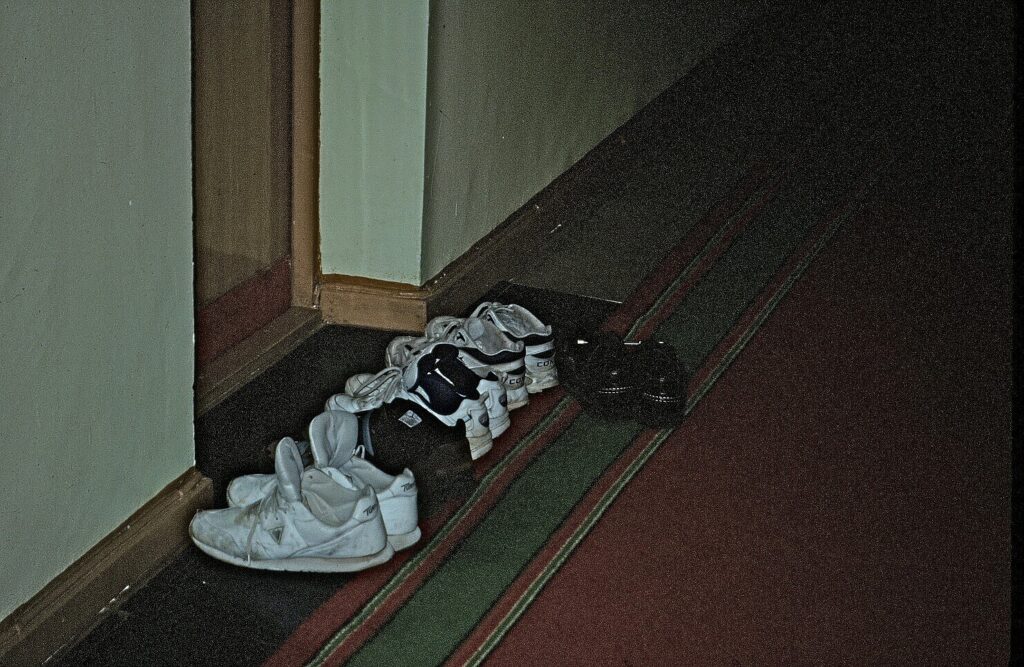
Shoes sit outside the room of “shoe-sign boy”
Lenny Tabaka (Sarov, November 1999)
